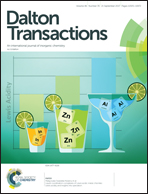2D-to-disguised 3D materials with built-in acid sites: H+-[Al]-RUB-18†
Abstract
Al3+ heteroions have been incorporated into the silicate layers of Na-RUB-18 in three different molar ratios Si/AlICP (22, 40 and 42) through a post-synthesis procedure under hydrothermal conditions. Systematic characterization (XRD, 29Si NMR, 27Al NMR and SEM) showed that these Na-[Al]-RUB-18 layered aluminosilicates are free from impurities, and the aluminum did not affect the crystallinity of the material, and also did not change its morphology. 27Al NMR showed that aluminum was incorporated in the tetrahedral position and the layered sample with molar ratio Si/AlICP = 22 has also displayed octahedral coordination. These layered aluminosilicates which consist of lamella stacking in the c direction had their interlayer space expanded by ion exchange with CTA+. The swollen samples were pillared with TEOS, as the SiO2 pillar precursor, and octylamine, as the hydrolyzing agent and co-surfactant. Pillared materials presented type IV isotherms with a BET surface area in the range of 223–323 m2 g−1 and mesoporous with 2–4 nm, while their layered precursors Na-[Al]-RUB-18 showed type II isotherms with a BET surface area in the range of 7–12 m2 g−1. Additionally, the acidity present in the layers of these pillared solids was proved by in situ ethanol dehydration monitored by FTIR.
![Graphical abstract: 2D-to-disguised 3D materials with built-in acid sites: H+-[Al]-RUB-18](/en/Image/Get?imageInfo.ImageType=GA&imageInfo.ImageIdentifier.ManuscriptID=C7DT02241G&imageInfo.ImageIdentifier.Year=2017)


 Please wait while we load your content...
Please wait while we load your content...